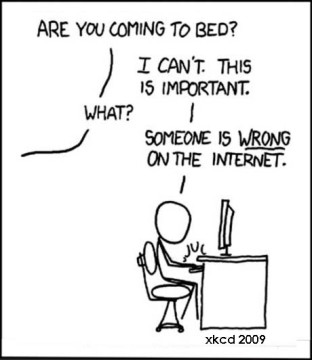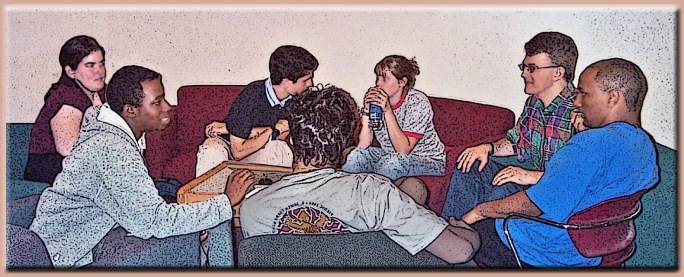Main points: Jeff Smith has more experience talking politics than most of us ever will. He believes that our neighborhood political conversations are better focus groups than those manufactured by political consultants, and that in our own informal focus groups we can learn why our neighbors believe what they believe and—yes—counteract misinformation. His advice for productive political conversation: Establish trust by listening to find the common ground.
I ca n count on one hand the times I’ve walked away from an opportunity for political conversation. But I’ve got nothing on Jeff Smith. As much as I enjoy talking politics, it had never occurred to me to stand by the side of the road with a sign saying “Stop and talk.”
n count on one hand the times I’ve walked away from an opportunity for political conversation. But I’ve got nothing on Jeff Smith. As much as I enjoy talking politics, it had never occurred to me to stand by the side of the road with a sign saying “Stop and talk.”
I’m always on the lookout for people with real-world experience in political conversation, so when I saw a photo of Jeff with his roadside conversation station, I knew I had to interview this man. True, he was doing something most of us will never do—running to keep his seat in the state legislature—but he was sure to have earned some insights useful to non-candidates who want to develop their political conversation skills.
We met over lunch in Eau Claire, Wisconsin, his home town. After losing his seat to redistricting, he is now running for chair of the state’s Democratic Party.
My first question was obvious: Is it so hard to start political conversations that even candidates have to put up a sign by the roadside?
Yes, it is. Forced to run in an area where voters didn’t know him well, Smith wanted to talk to as many voters as he could. Going door-to-door found only about one in five voters home, and fewer than half of those were willing to talk. As he walked through the silent neighborhoods, he could hear the traffic on nearby highways. So he painted his sign, parked by the road, and waited.
It worked better than going door to door, but still “about half the time, I was on my own,” Smith recalled. And although he is a Democrat, about 75% of the people who stopped to talk were conservatives.
Once the conversation gets started, however, Smith found he could talk to anyone—even the few who were itching for a fight.
“You could see them all tensed up as they approached. But if you let them talk, sooner or later you would hear something to the effect of, “I’m concerned about my school.”
And that was the opening Smith, with his experience as a parent and an education advocate, could use. He could then connect: “Well, I am, too. What are we going to do about that?”
“The common ground is always there,” Smith said. “That’s what you wait for. If you let them talk and you listen enough, you will always hear it.” Once the conversation finds that common ground, he said, “then you’ve got a foundation of trust. That allows the communication to get going.”
Smith takes exception to the common assumption that “if you’re listening and having a two-way conversation, you’re weak, you lack passion, you’re not really committed.”
It’s just the opposite, he explained. “When you tell people just what you want them to hear, it never works. When you get in someone’s face, you can expect them to dig in their heels. You might walk away satisfied that you have been heard, but you haven’t really accomplished anything.”
Smith has used the power of listening to counter misinformation, even to turn enemies into allies. For example, while in the state legislature, Smith sponsored a bill addressing the problem of puppy mills—inhumane, for-profit dog-breeding operations. The leadership of an otherwise reputable kennel club had been spreading misinformation about Smith’s proposed legislation.
The members of the club organized a lobby day at the Capitol and confronted Smith with “about 30 people ready to read me the riot act.” The president of the kennel club read a long statement, “a diatribe about how awful the bill was, how reputable breeders would be raided and have their dogs confiscated—that sort of thing.” Smith remained quiet to “let them let it out.” When the group felt they had been heard, they were ready to listen. Smith then asked, “How many of you sell more than 50 dogs a year from more than three litters?” Not a hand in the room went up.
“Well, then, this bill won’t affect you. “ Conversation began, and the group ended up supporting the bill.
He recognizes it’s an uphill struggle. “There’s so much anger, so much fear. The stuff they see on television, hear on talk radio, get in their mailbox—it’s all designed to cast fear,” Smith continued, recalling one woman who greeted him with “You Democrats are all corrupt.”
“It was almost as if she didn’t realize she was talking about me to my face,” he marveled. “But if we don’t understand where that comes from, we’re never going to be able to make it go away.”
Smith’s response gently highlighted the specific and personal nature of her comment: “I asked, ‘Why do you think I am corrupt? As far as I can see, we have to have talked to each other before you can say I’ve lied to you.’”
That sort of honest but calm and respectful conversation is key to helping your conversation partner realize he or she is talking to “a person just like me, not a caricature.”
“People have reasons for believing the things they believe,” Smith continued. “You need to listen until you understand what those reasons are. You need to hear. That’s what people really want—to be heard.”
Smith is disappointed when he hears any of his fellow progressives dismissing Republican voters as “voting against their best interests,” before they’ve listened to them in one-on-one conversation. “You need to hear from them what their best interests are,” he explained. By the same token, “They cannot listen to Fox News to tell them who I am.”
Focus groups—a market-research technique in which a group of people are asked about their perceptions, opinions, and beliefs, and then discuss them with other group members–are widely accepted as a technique for understanding voters’ minds. Smith, however, is wary of the focus groups run by political consultants, which he characterized as “manufactured groups with manufactured diversity that produce manufactured results.” He’ll consider their findings, but won’t take them as gospel.
He strongly encourages politically engaged citizens to use their own social gatherings as naturally forming, real-life focus groups. I was reminded of the annual Christmas-tree bonfire my husband and I host for our neighborhood. I told him of last year’s bonfire, in which the question of gas prices came up. As one neighbor to expressed support for the XL pipeline, his remarks about “American oil companies” gave his neighbors the opportunity to point out something he hadn’t yet considered–that the Canadian oil will be sold on the global market by global corporations that have no national loyalty, with no advantage for the American consumer or benefit to the American taxpayer.
That’s the sort of community connection Smith thinks can make a difference. “We’ve got to remember that we’re working for the good of the whole community. All this political stuff we do–it’s about belonging to the same community, bring ourselves back to our shared humanity, our shared challenges.”
And if you’re dealing with someone who knows your political beliefs and doesn’t agree with them, the conversation doesn’t even have to be about politics and can still help to build the bridges needed to heal our civic divisions.
Smith had recently run into an old acquaintance at a social gathering, who hasn’t talked to him since Smith entered politics. Smith explained, “I could tell he is one of those who assume that since we’re on different teams now, we need to be mad at each other.”
So when his old friend gave him nothing more than a grunt in response to a warm greeting, Smith ignored the signal and instead started “a nice little conversation—some old memories, the Packers, whatever. That’s all I needed to do.”
“It worked. Pretty soon, we were chatting like the old friends we are. Next time, he’ll talk to me.”
 Example: Suppose you support funding for contraception services. You think your strongest arguments are the basic dignity of human choice; the morality of caring for our fellow citizens; reducing the demand for abortion; and strengthening our economy by enabling people to manage the size of their families.
Example: Suppose you support funding for contraception services. You think your strongest arguments are the basic dignity of human choice; the morality of caring for our fellow citizens; reducing the demand for abortion; and strengthening our economy by enabling people to manage the size of their families.




 what happens when we insult people. It took a little longer, but most of us eventually learned the value of not taking offense even when it is handed to us, even we still have a hard time with that practice.
what happens when we insult people. It took a little longer, but most of us eventually learned the value of not taking offense even when it is handed to us, even we still have a hard time with that practice. Articles:
Articles:

